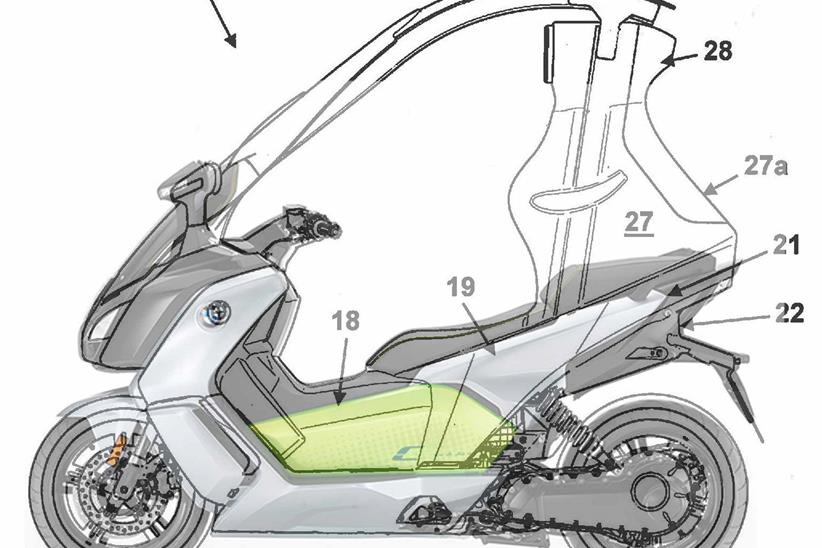Reborn electric BMW C1 gets airbags, safety cell, active aero and can be ridden as a normal bike

Before BMW’s R1250GS took up residence at the top of the sales charts the German firm spent years searching for a machine that would bring it to prominence – and as the millennium dawned it was the BMW C1 scooter-with-a-roof that was briefly the company’s most striking offering.
Although remembered today as a short-lived, bizarre-looking dead-end, the C1 offered in 125cc and 176cc (“200”) forms was BMW’s best-selling two-wheeler in the UK from 2001 until it was discontinued in 2003. British sales accounted for around a quarter of the total 12,000 machine production run.
Related articles on MCN
![]()
Now the firm could be working to bring the same concept back and have filed at least 15 new patent applications showing every aspect of a new, battery-powered C1 successor based on the chassis of the C Evolution scooter.
Like its predecessor, the aim is to provide car-like levels of safety on two wheels, but in a break from the past BMW’s new design offers customers the option of removing the entire safety cell – creating a dual-purpose machine that can be a fun, open-air motorcycle at weekends and a car-like commuter during the week.
BMW’s latest patent applications come more than a year after a first, tentative indication of the plan in an initial patent document showing the removable roof layout, indicating that this is a serious, ongoing project which inevitably uses a host of innovative technologies to achieve its goal of combining car-like safety with the traffic-busting practicality of a bike.
Should it reach production, it won’t be cheap. The C Evolution that provides its aluminium platform and electric drivetrain is already a £14k bike, and the carbon-fibre roof structure, airbags, seatbelts and active aerodynamics with moveable winglets seem sure to push the price north of £20k.
A lot for a commuter machine? Perhaps not if seen as an alternative to cars, congestion and emissions charges, let alone costly railway season tickets that are made even less attractive by Covid-19.
With weather protection and no need to wear riding kit – in many countries even a helmet isn’t needed on a C1 scooter – BMW’s idea offers a two-wheeled solution that doesn’t currently exist on the market.
The roofed scoot idea is one that’s never totally left BMW, even after the C1 was dropped. The firm revived it for the one-off C1-E prototype in 2009, which added an electric drivetrain and previewed the C Evolution, even though the production version lacked the roof.
With its latest take on the idea, the ability to remove that roof could be the key to its success, creating two bikes for the price of one.
![]()
Blowing the roof off: BMW concept explored
- Carbon-fibre roof: Instead of the old alloy top, the new BMW uses a carbon safety cell with an element of flex to absorb impacts.
- Rear impact protection: The seat back contains another rigid structure and crushable pads to absorb impacts from behind.
- Seatbelts: Shoulder belts and a waist strap connect into a four-point harness. They’re car-style inertia reels to give free movement.
- Cabriolet: A few bolts hold the entire safety cell in place, including the airbags, seatback and seatbelts to create a more bike-like ride.
- Crumple zones: The two carbon roof hoops bolt to sacrificial alloy sections that get crushed in an accident and dissipate energy.
- Side airbags: An airbag near each of the rider’s shoulders expands into a head-to-hip curtain in a crash to keep arms inside.
- Airflow in mind: Ducts channel air inside the screen to stop misting. Rear visibility comes courtesy of mirrors in the pillars.



